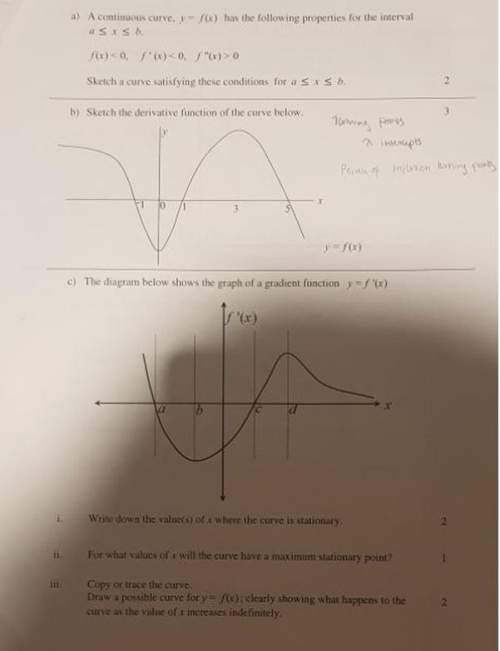
Mathematics, 06.04.2021 20:40 capo5094
Use the sequence {−1,171,875;−234,375;−46,875;−9375, …} to answer the question.
What is the explicit rule that describes the sequence?
an=−1,171,875(125)n−1
an=1,171,875(−15)n−1
an=−1,171,875(15)n−1
an=1,171,875(−115)n−1

Answers: 2


Another question on Mathematics

Mathematics, 21.06.2019 19:30
The amount spent on food and drink by 20 customers is shown below what is the modal amount spent and the median amount spent? 40 25 8 36 18 15 24 27 43 9 12 19 22 34 31 20 26 19 17 28
Answers: 1


Mathematics, 21.06.2019 23:00
In january 2010, you began a one-year study of tuberculosis (tb) in a subsidized housing community in the lower east side of new york city. you enrolled 500 residents in your study and checked on their tb status on a monthly basis. at the start of your study on january 1st, you screened all 500 residents. upon screening, you found that 30 of the healthy residents had been vaccinated for tb and therefore were not at risk. another 20 residents already had existing cases of tb on january 1st. on february 1st, 5 residents developed tb. on april 1st, 10 more residents developed tb. on june 1st, 10 healthy residents moved away from new york city and were lost to follow-up. on july 1st, 10 of the residents who had existing tb on january 1st died from their disease. the study ended on december 31, 2010. assume that once a person gets tb, they have it for the duration of the study, and assume that all remaining residents stayed healthy and were not lost to follow-up. is the subsidized housing community in the lower east side of new york city a dynamic or fixed population? briefly explain the rationale for your answer. dynamic population it can changeable people can move out and move in into the population of a subsidized housing what was the prevalence of tb in the screened community on january 1st? prevalence = 30/500 0.06= 6% what was the prevalence of tb on june 30th? prevalence= 40/450=0.08= 8.88% what was the cumulative incidence of tb over the year? cumulative incidence = number of new cases/number in candidate population)over specified time period 10/450 = 2.2% suppose that you wanted to calculate the incidence rate of tb in the study population. calculate the amount of person-time that would go in the denominator of this incidence rate. be sure to show your work.
Answers: 2

Mathematics, 22.06.2019 00:30
Can someone me find the original price? the discount is 5% and the sale price is $68.40
Answers: 1
You know the right answer?
Use the sequence {−1,171,875;−234,375;−46,875;−9375, …} to answer the question.
What is the explici...
Questions

History, 06.12.2019 07:31


English, 06.12.2019 07:31

Mathematics, 06.12.2019 07:31



English, 06.12.2019 07:31


History, 06.12.2019 07:31

Mathematics, 06.12.2019 07:31


Mathematics, 06.12.2019 07:31

Mathematics, 06.12.2019 07:31


History, 06.12.2019 07:31



Chemistry, 06.12.2019 07:31

History, 06.12.2019 07:31

Mathematics, 06.12.2019 07:31




